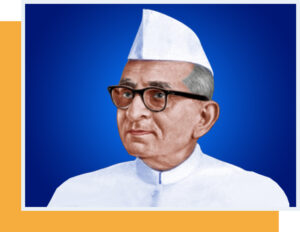Our Founder
 Kulapati Kanaiyalal Maneklal Munshi, had a humble origin. He was born at Broach (Gujarat) on December 30, 1887, to Tapibehn and Maneklal. He completed his school and collegiate education, the latter in Baroda where he had Sri Aurobindo as one of his teachers (1902). Sri Aurobindo’s inspiring writings in Yugantar, Bande Mataram and Karmayogi were read by Munshi avidly.
Kulapati Kanaiyalal Maneklal Munshi, had a humble origin. He was born at Broach (Gujarat) on December 30, 1887, to Tapibehn and Maneklal. He completed his school and collegiate education, the latter in Baroda where he had Sri Aurobindo as one of his teachers (1902). Sri Aurobindo’s inspiring writings in Yugantar, Bande Mataram and Karmayogi were read by Munshi avidly.
Munshi entered the legal profession in 1913 in Mumbai. With a flourishing practice at the Bar, he was, however, drawn to politics, first to Dr. Annie Besant and later to Mahatma Gandhi. Under the latter’s leadership, he participated in the Salt Satyagraha in 1930 and was imprisoned for six months; later in 1932, he was sentenced to two years’ rigorous imprisonment.
Munshi’s public career began with his entry into the Bombay Legislative Council in 1927 and reached its zenith in the Constituent Assembly (1946-50). As a member of the Drafting Committee of the Indian Constitution, he contributed substantially to the provisions relating to the minorities, the official language and the judiciary. He was an advocate of Hindi as the official language but was against linguistic fanaticism. He was a lover of English language and literature and harboured no hatred of the English as a race. As one who believed in the unity of India with a strong Centre, and as legal adviser to some State rulers, he played a decisive role in the integration of States; he favoured Police Action in Hyderabad as the Indian Agent there in 1948.
Dr. Munshi as Minister in the State of Bombay (1937-39) and at the Centre (1950-52), initiated many salutary measures in the fields of law and order, education and agriculture. He was a great lover of Sanskrit and a champion of its cause. One of the first institutions he set up was the Mumbadevi Sanskrit Mahavidyalaya; this was followed by the Sanskrit Vishwa Parishad.
In spite of his pre-occupation with the legal profession and manifold public activities, Munshi found time to produce an uninterrupted stream of stories, novels, plays and essays. Munshi’s works in Gujarati are characterised by volume, variety and vigour and include Social Plays, Social Novels, Short Stories, Historical Romances and Drama, Puranic Dramas and Novels and many more. Equally varied in theme are his books in English. They range from political polemics to philosophy.
Dr. Munshi, in his individual capacity, earned a name for himself as ‘a Dynamic Builder’. The institutions he has founded cover a wide range-agriculture, care of destitute children, education, literature and the arts, publication of books etc. He was associated with several journals in Hindi, Gujarati and English. He was an ardent advocate of social reform and opposed casteism and untouchability.
The reconstruction of the much desecrated Somnath temple in 1948, in the teeth of opposition from some national leaders, was at once a reflection of his faith in God and Dharma and zeal for worthy causes.
The Bharatiya Vidya Bhavan, which Dr. Munshi founded in 1938, was the crowning glory of a life dedicated to noble causes and great purposes. He looked upon the Bhavan as an instrument for translating into reality his vision of an India unshaken by the ‘technological avalanche’ and rooted in the values of an immemorial culture that, while not denying worldly joys, aspires for the life of the spirit. It was under the ageis of the Bhavan that he gave a concrete shape to his view of history from a national perspective and the 11-volume History and the Culture of the Indian People was the result.
Apart from Bhavan, Dr. Munshi was also founder of many other Institutions such as Hansraj Morarji Public School, Mumbai, Children’s Aid society, Mumbai, Somnath Temple Trust etc. etc.
Above all, Dr. Munshi was a humanist. He was a man of religion but not a religious fanatic. Modern in his outlook, he looked to the past to strengthen the cultural roots of the present. He was, as he chose to describe himself, ‘a sea shell thrown up by the mighty flood of Indian renaissance.’
The end of Dr. Munshi, the man who was an institution in himself, came on Feb. 8, 1971, when he was 84.
